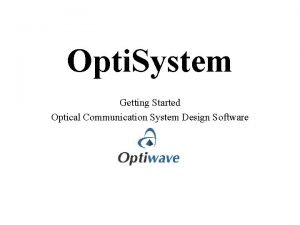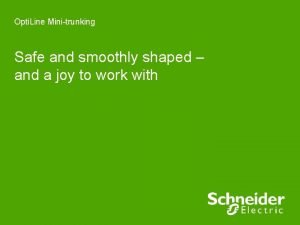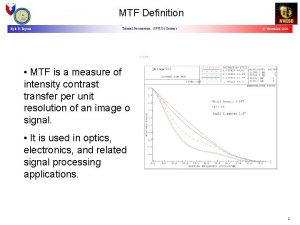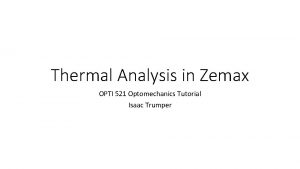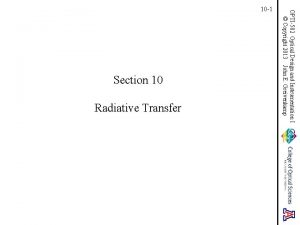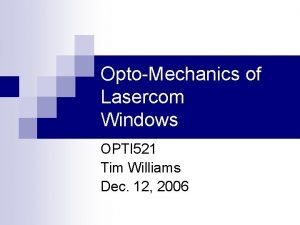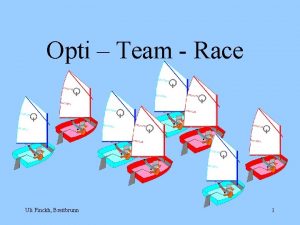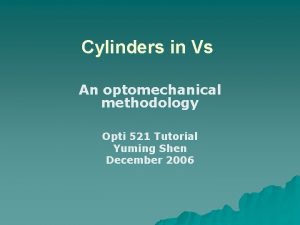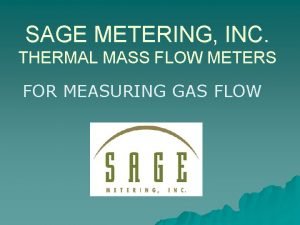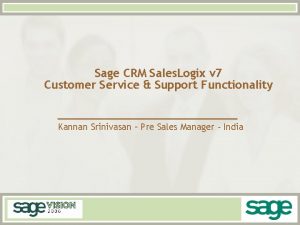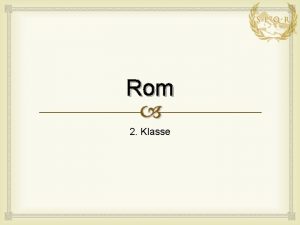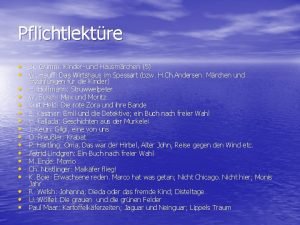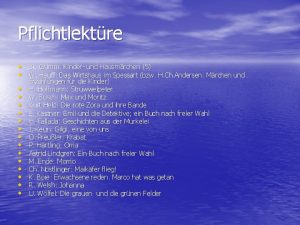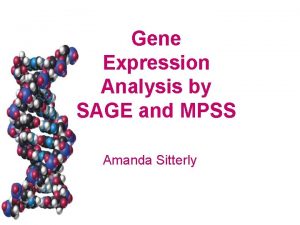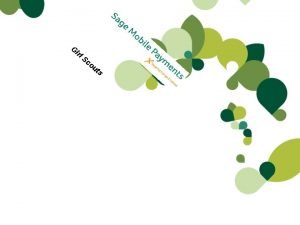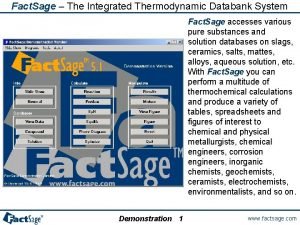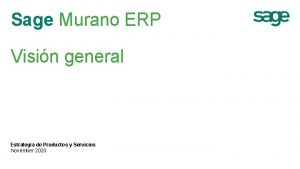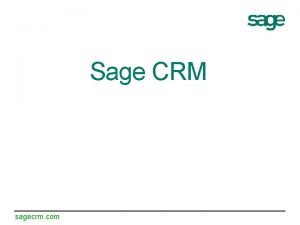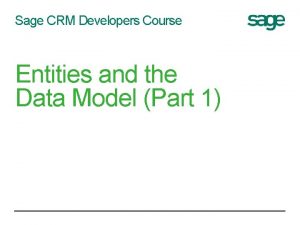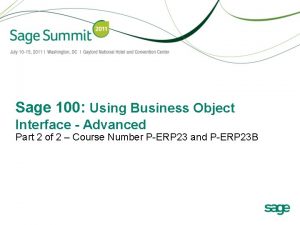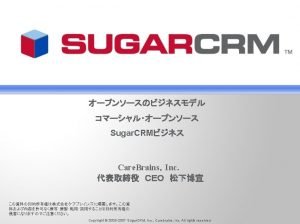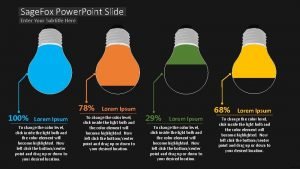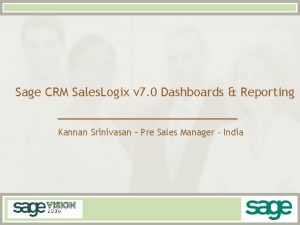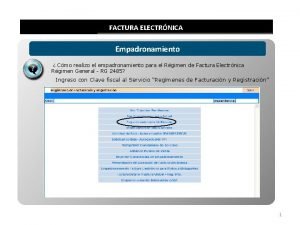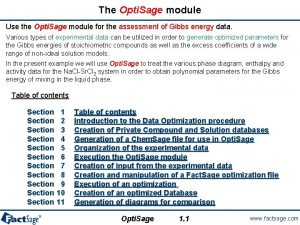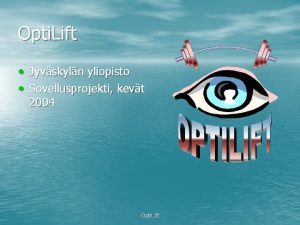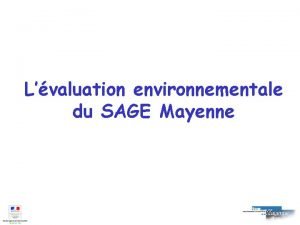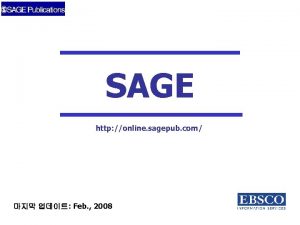The Opti Sage module Use the Opti Sage




















































































- Slides: 84

The Opti. Sage module Use the Opti. Sage module for the assessment of Gibbs energy data. Various types of experimental data can be utilized in order to generate optimized parameters for the Gibbs energies of stoichiometric compounds as well as the excess coefficients of a wide range of non-ideal solution models. In the present example we will use Opti. Sage to treat the various phase diagram, enthalpy and activity data for the Na. Cl-Sr. Cl 2 system in order to obtain polynomial parameters for the Gibbs energy of mixing in the liquid phase. Table of contents Section Section Section 1 2 3 4 5 6 7 8 9 10 11 Table of contents Introduction to the Data Optimization procedure Creation of Private Compound and Solution databases Generation of a Chem. Sage file for use in Opti. Sage Organization of the experimental data Execution the Opti. Sage module Creation of input from the experimental data Creation and manipulation of a Fact. Sage optimization file Execution of an optimization Creation of an optimized Database Generation of diagrams for comparison Opti. Sage 1. 1 www. factsage. com

Introduction to the Data Optimization procedure The Opti. Sage module is used to generate a consistent set of Gibbs energy parameters from a given set of experimental data using known Gibbs energy data from well established phases of a particular chemical system. Typical experimental data include: – phase diagram data: transitions temperatures and pressures as well as amount and composition of the phases at equilibrium – calorimetric data: enthalpies of formation or phase transformation, enthalpies of mixing, heat contents and heat capacity measurements – partial Gibbs energy data: activities from vapor pressure or EMF measurements – volumetric data: dilatometry, density measurements. The assessor (user of Opti. Sage) has to use his best judgement on which of the known parameters should remain fixed, which set of parameters need refinement in the optimization and which new parameters have to be introduced, especially when assessing data for non-ideal solutions. Opti. Sage 2. 1 www. factsage. com

Overview of the data to be optimized in the Na. Cl-Sr. Cl 2 system Various experimental data on the binary Na. Cl-Sr. Cl 2 system are available: – phase diagram data (liquidus points, eutectic points) – liquid-liquid enthalpy of mixing (at 894°C) – activity of Na. Cl(liq) at 3 different temperatures (800°C, 825°C and 850°C) Opti. Sage will be used to optimize the parameters for the liquid Gibbs energy model (XS terms). All other data (G° of the pure stoichiometric solids, as well as the pure liquid components) will be taken from the FACT database (i. e. remain fixed). A polynomial model for the Gibbs energy of the liquid will be used: G = (X 1 G° 1 + X 2 G° 2) + RT(X 1 ln X 1 + X 2 ln X 2) + GE where GE = DH – TSE Using the binary excess terms: DH = X 1 X 2 (A 1) + X 12 X 2 (B 1) SE = X 1 X 2 (A 3) + X 12 X 2 (B 3) Hence: GE = X 1 X 2 (A 1 - A 3 T) + X 12 X 2 (B 1 - B 3 T) Where A 1, A 3, B 1 and B 3 are the 4 parameters to be optimized. G° 2 G° 1 G Opti. Sage Na. Cl XSr. Cl 2 2. 2 Sr. Cl 2 www. factsage. com

The 3 Steps in the Optimization Procedure In general a three step procedure is adopted for the optimization: Step 1. Set a thermodynamic datafile (Chem. Sage file) Step 2. Organise the various experimental data values (Excel file) Step 3. Execute the optimization program interactively (run Opti. Sage) In order to create a Chem. Sage file (step 1. ), it is necessary to use the Compound, Solution and Equilib modules as outlined in the following slides. Opti. Sage 2. 3 www. factsage. com

Creation of a private (r/w) compound database • Opti. Sage uses a Chem. Sage thermodynamic datafile containing all known and unknown (to be optimized) model parameters. The Chem. Sage file is created by Equilib. • G° of each component of the liquid phase is taken from the FACT database. Component Index G° Na. Cl 1 Liquid from FACT Sr. Cl 2 2 Liquid from FACT • You have to create a private r/w (read/write) COMPOUND database containing Na. Cl(liq) and Sr. Cl 2(liq) using the Compound module. Public data (read-only) cannot be used in Opti. Sage. • To create a private Compound database: see Compound section 3. • To transfer data between databases: see Compound section 11. Opti. Sage 3. 1 www. factsage. com

Private Compound Database A private Compound database nicknamed USER containing Na. Cl and Sr. Cl 2 should look like: Note: Gaseous Na. Cl and Sr. Cl 2 are not needed in the present example. Opti. Sage 3. 2 www. factsage. com

Creation of a new solution database • You have to create a private solution file containing all parameters (either known and/or to be optimized) for each solution phase to be optimized. You cannot perform an optimization using a public database (read-only) such as FACT. • The solution file must include all parameters to be optimized (with their coefficients set to zero or to any initial value). • For the Na. Cl-Sr. Cl 2 system: – one phase is to be optimized: the liquid solution. – a polynomial model will be used (see slide 3). 4 coefficients are set to zero: i. e. A 1 = A 3 = B 1 = B 3 = 0 • A solution database nicknamed SOLUTION has been created using the Solution module. – to create a private solution database: see Solution section 5. • Save this solution file. Opti. Sage 3. 3 www. factsage. com

Private Solution Database In the Solution module, a new private solution database named SOLUTION. dat should look like: Nickname of the liquid solution Name of the liquid solution Polynomial Model Excess parameters (i. e. A 1, A 3, B 1 and B 3) are set to 0 Opti. Sage 3. 4 www. factsage. com

Generation of a Chem. Sage file The following four slides show the above Compound and Solution private databases are linked with the Equilib module, and how the selection of the relevant phases in Equilib is used to generate the Chem. Sage file. Opti. Sage 4. 0 www. factsage. com

Creation of a Chem. Sage file for the optimization The procedure is: – open the Equilib module – enter the components Na. Cl and Sr. Cl 2 in the Reactants window of Equilib Opti. Sage 4. 1 www. factsage. com

Adding your private databases to Fact. Sage list of databases Do not forget to add and activate the newly created private databases to the list of databases in the Equilib module (see Equilib Advanced slide 26. 3 and Phase Diagram slide 6. 1). From the Menu Bar in the Reactants-Equilib window, select: Data Search Make sure that the ELEM compound database is also selected and that the FACT databases are not selected. …and add your read and write (r/w) databases Opti. Sage 4. 2 www. factsage. com

Equilib Menu window – in the Menu window of Equilib, select all the species and the solutions (including the solution(s) to be optimized) involved in the actual optimization from your USER databases. – save a Chem. Sage (ASCII format *. dat) file. In the menu bar, select File > Chem. Sage file > Save Chem. Sage file… Opti. Sage 4. 3 www. factsage. com

Saving a Chem. Sage File Saving an ASCII Chem. Sage file (*. dat) under the name : Na. Cl_Sr. Cl 2. dat Opti. Sage 4. 4 www. factsage. com

Experimental datasets to be used in the optimization Step 2: Organize the experimental data. Various types of experimental data can be used in an optimization. In the present example activity data, enthalpies of mixing and phase diagram data will be employed. Each phase boundary will be treated as a separate dataset. Each datasets will be given the name GROUP #1, #2, …, #5. This leads to five different datasets. The following three slides show the five different groups are defined. Opti. Sage 5. 0 www. factsage. com

Group #1 – Experimental Data Points: Activity Data. • We want to optimize the experimental data to obtain the model parameters for the Na. Cl-Sr. Cl 2 liquid phase. • Data are divided into five different groups where each group corresponds to a specific type of Equilib calculation. • Group #1: Activity of Na. Cl in the liquid phase – Experimental conditions: – Measured variables: 1 a. Na. Cl (liquid ref. state) • Amount of Na. Cl in the liquid phase (Na. Sr. Cl) • Amount of Sr. Cl 2 in the liquid phase (Na. Sr. Cl) • Temperature • Pressure • Activity of Na. Cl in the liquid phase (Na. Sr. Cl) – Selected phases: Ostvold(850 C) 0. 8 Egan and Bracker(825 C) 0. 7 Emons et al. (800 C) Opti. Sage o o 0. 6 0. 5 0. 4 0. 3 0. 2 0. 1 0 • Liquid phase (Na. Sr. Cl) o 0. 9 0 0. 2 5. 1 0. 4 0. 6 Mole fraction Sr. Cl 2 0. 8 1 www. factsage. com

Group #2 – Heat of mixing data Group #2: Enthalpy of mixing of the Na. Cl-Sr. Cl 2 liquid mixture at 1167 K (894°C). – Experimental conditions: Amount of Na. Cl(liquid) Amount of Sr. Cl 2(liquid) Initial Temperature Initial Pressure Final Temperature Final Pressure – Measured variables: • Enthalpy of mixing (liquid) – Selected phases: • Liquid phase (Na. Sr. Cl) 0 Enthalpy of mixing (k. J/mol) • • • -0. 25 o -0. 5 Exp. Points of Ostvold (894 C) -0. 75 -1 0 0. 2 0. 4 0. 6 0. 8 1 Mole fraction Sr. Cl 2 Opti. Sage 5. 2 www. factsage. com

Groups #3, #4 and #5 – Data related to phase equilibria. • • Group #3: Eutectic temperature Group #5: Sr. Cl 2 liquidus data – Experimental conditions: • • • Amount of Na. Cl in the liquid phase (Na. Sr. Cl) Amount of Sr. Cl 2 in the liquid phase (Na. Sr. Cl) Pressure – Measured variables: • Temperature (Formation Target on Na. Sr. Cl) • • • Liquid phase (Na. Sr. Cl) Na. Cl(s) Sr. Cl 2(s 1) Amount of Na. Cl(s) Amount of Sr. Cl 2(s 1) Pressure – Measured variables: • Temperature (Formation Target on Na. Cl(s)) Scholich Vortisch Bukhalova o 800 801 S 2 o • • • o 874 Group #4: Na. Cl liquidus data – Experimental conditions: Liquid phase (Na. Sr. Cl) Sr. Cl 2(s 1) Sr. Cl 2(s 2) 900 Temperature C) ( • Temperature (Precipitation Target on Na. Sr. Cl) – Selected phases: • • • Amount of Na. Cl(s) Amount of Sr. Cl 2(s 1) Pressure Liquid 700 Liquid phase (Na. Sr. Cl) Na. Cl(s) 727 S 1 600 – Selected phases: • • o o 565 500 0 0. 2 0. 4 0. 6 0. 8 1 Mole fraction Sr. Cl 2 Opti. Sage 5. 3 www. factsage. com

Experimental Data The experimental data are stored in an Excel spreadsheet. Opti. Sage 5. 4 www. factsage. com

Executing the Opti. Sage module Step 3. Execute the optimization program interactively. When thermodynamic datafile (Chem. Sage file) has been created (Step 1. ) and the numerical values of the experimental data to be used in the optimization have been organised into groups (Step 2. ), the Opti. Sage module can be executed and the Chem. Sage file loaded. The following two slides show to initiate Opti. Sage 6. 0 www. factsage. com

The Opti. Sage Module • After creating : – a compound database – a solution database – a Chem. Sage file • and organising the experimental data into groups • Opti. Sage is ready to be employed Opti. Sage 6. 1 www. factsage. com

Opti. Sage main window: New optimization • Open a new optimization. • Select File > New from the Menu bar or click on from the toolbar to open a New optimization. Opti. Sage Then open your Chem. Sage file by selecting: 1. File > Open Chem. Sage File from the Menu bar, or 2. Thermodynamic File from the treeview and double-click to select an input Chem. Sage thermodynamic file. 6. 2 www. factsage. com

Creating Opti. Sage input for the experimental data The thermodynamic data of the system are already stored since thermodynamic datafile also contains the names of the phases and their constituents. The following eight slides show the data for experimental Group #1, Activities of the components in the liquid phase at a given temperature, are entered into the calculation. NOTE: For all experimental input, there is a distinction made between the experimental conditions and the measured variables. In the present case, activities have been measured as function of temperature and composition. Thus temperature and composition (as well as total pressure) are experimental conditions and the measured activities are the measured variables. Different parts of the input window are used for these different data. Opti. Sage 7. 0 www. factsage. com

Importing the data into Group #1 Open the Chem. Sage file previously created. At this point, the Opti. Sage window shows the tree view (fully expanded) and we are ready to enter the experimental data that will be used in the optimization. A right-click on Experimental Data opens the pop-up menu. Select <Add> to open the ‘Add Group’ window. Opti. Sage 7. 1 www. factsage. com

The Add Group window Enter the description of group #1: Activity of Na. Cl in the liquid phase «initial conditions» are only checked when DH, DG, DV, DS or DCp are calculated. (ex: adiabatic T, DHmix, etc…) Select units A right-click in each spreadsheet opens a pop-up menu where you can add, edit, delete, load from a file, save to a file either the Experimental Conditions or the Measured Variable(s) Opti. Sage 7. 2 www. factsage. com

Adding new Experimental Conditions • Group #1: Activity of Na. Cl in the liquid phase 1. Experimental conditions: 1. 2. 3. 4. 2. Measured variables: 1. 3. Amount of Na. Cl in the liquid phase (Na. Sr. Cl) Amount of Sr. Cl 2 in the liquid phase (Na. Sr. Cl) Temperature Pressure Activity of Na. Cl in the liquid phase (Na. Sr. Cl) Selected phases: 1. 2. Enter an experimental condition. For example, temperature, on a linear scale X. Liquid phase (Na. Sr. Cl) 1. Right-click in the Experimental Conditions spreadsheet and select Add variable… from the pop-up menu or click on the button in the menu bar to open the Add Experimental Conditions window. 3. Click OK. 4. Repeat for the 3 other experimental conditions. Opti. Sage 7. 3 www. factsage. com

The «Add Experimental Condition» Window Note: Choosing the experimental conditions is equivalent to entering reactants and fixing final conditions in Equilib. List of the experimental conditions you can declare. List of scales available List of the phases available (when the option is enabled) List of the phase constituents available when needed. List of streams (max. 20) Enabled when the «initial conditions» checkbox in the unit frame of the Add Group window is checked and needed when there’s any difference between the initial and the final conditions Opti. Sage 7. 4 www. factsage. com

Adding the 3 other experimental conditions of Group #1 Changing Units Pressures are in bar and your data are in atm. Select the appropriate unit. Opti. Sage 7. 5 www. factsage. com

Adding new Measured Variables • Group #1: Activity of Na. Cl in the liquid phase 1. Experimental conditions: • • Amount of Na. Cl in the liquid phase (Na. Sr. Cl) Amount of Sr. Cl 2 in the liquid phase (Na. Sr. Cl) Temperature Pressure 2. Measured variables: Activity of Na. Cl in the liquid phase (Na. Sr. Cl) 3. Selected phases: Liquid phase (Na. Sr. Cl) Opti. Sage 7. 6 www. factsage. com

Adding a Measured Variable 1. Right-click in the Measured Variable(s) spreadsheet and select Add variable… from the pop -up menu or click on the button in the menu bar to open the Add Measured Variable window. 2. Enter a measured variable. Here, the activity of Na. Cl in the Na. Sr. Cl phase on a linear scale X. 3. Click OK. 4. Repeat for the other measured variables if necessary. Opti. Sage 7. 7 www. factsage. com

The «Add Measured Variable» Window List of the measured variables you can declare. List of scales available List of the phases available (when the option is enabled) List of the phase constituents available when needed. More available for aqueous systems. The Target frame is enabled if the final T (P or <A>) is not specified. See slide 7. 22. Opti. Sage 7. 8 www. factsage. com

Group #1: declaration of variables The declaration of all variables is completed. The «Add Group» window should look like: Opti. Sage Each Measured Variables declaration creates 2 columns: • One for the data • One for the estimated error (positive absolute value) 7. 9 www. factsage. com

Import the data into Group #1 You can enter your data manually or, if your data are in a spreadsheet, copy and paste them in the «Add Group» window. 1. Copy of 2 colums of data in EXCEL 2. Right-click in the first cell in Opti. Sage to select Paste. Experimental or estimated error should be entered to be considered in the optimization. If a cell is blank or has a value of zero the corresponding data will be ignored. Opti. Sage 7. 10 www. factsage. com

Group #1, Selection of the phases 1. Experimental conditions: – – 2. By default, all phases are eliminated Amount of Na. Cl in the liquid phase (Na. Sr. Cl) Amount of Sr. Cl 2 in the liquid phase (Na. Sr. Cl) Temperature Pressure Measured variables: Activity of Na. Cl in the liquid phase (Na. Sr. Cl) 3. Selected phases: Liquid phase (Na. Sr. Cl) This is equivalent to species selection in Equilib To select a phase: 1. Click on a phase in the Eliminated frame and 2. Drag it in the Entered(Stable) frame Opti. Sage 7. 11 www. factsage. com

Saving experimental data and closing Group #1 To save data and return to the Opti. Sage main window, select File > Save and close To select or unselect all points, use Edit > Select (or Unselect) all points Warning: Reset will clear all the entries in the Add Group #1 window To format the experimental data spreadsheet cells, use the pop-up menu (right-click in the spreadsheet) Opti. Sage 7. 12 www. factsage. com

Importing the data into Group #2: Enthalpy of mixing of the Na. Cl-Sr. Cl 2 liquid mixture at 1167 K (894°C). A right-click on Experimental Data opens the pop-up menu. Select <Add> to open the ‘Add Group’ window. Opti. Sage 7. 13 www. factsage. com

Group #2: Heat of mixing data Enthalpy of mixing of the Na. Cl-Sr. Cl 2 liquid mixture at 1167 K (894°C) 1. stream 1 Na. Cl (liquid) T 1 P 1 Experimental conditions: – – – Amount of Na. Cl(liquid) Amount of Sr. Cl 2(liquid) Initial Temperature Initial Pressure Final Temperature Final Pressure 2. Initial conditions Measured variables: – Enthalpy of mixing (liquid) 3. Final conditions Selected phases: – Liquid phase (Na. Sr. Cl) stream 2 Sr. Cl 2 (liquid) T 2 P 2 Mixture of Na. Cl-Sr. Cl 2 (liquid) T P DHmix Enthalpy of mixing (k. J/mol) 0 -0. 25 -0. 5 Here, P=P 1=P 2= 1 atm T=T 1=T 2= 1167 K o Exp. Points of Ostvold (894 C) -0. 75 -1 0 0. 2 0. 4 0. 6 Mole fraction Sr. Cl 2 0. 8 1 Opti. Sage 7. 14 www. factsage. com

Group #2: Declaration of Experimental Conditions 1. Enter a group description 2. Select the units 3. Check the initial conditions 4. Declare all Experimental Conditions: • Amount of Na. Cl(liquid) • Final Pressure (P) • Amount of Sr. Cl 2(liquid) • Initial Temperature [ T 1 , T 2 ] • Initial Pressure [ P 1 , P 2 ] • Final Temperature [ Initial conditions ] [ T 1 ] [ T 2 ] (T) [ P 1 ] [ P 2 ] Amount of Na. Cl(liquid) Amount of Sr. Cl 2(liquid) (T) (P) Opti. Sage (Final conditions) 7. 15 www. factsage. com

Group #2: Declaration of the Measured Variable 1. Experimental conditions: – – – Amount of Na. Cl(liquid) Amount of Sr. Cl 2(liquid) Initial Temperature Initial Pressure Final Temperature Final Pressure 2. Measured variables: – Enthalpy of mixing (liquid) 3. Selected phases: – Liquid phase (Na. Sr. Cl) stream 1 Na. Cl (liquid) T 1 P 1 stream 2 Sr. Cl 2 (liquid) T 2 P 2 Mixture of Na. Cl-Sr. Cl 2 (liquid) T P DHmix Opti. Sage 7. 16 www. factsage. com

Group #2: Summary of the variables When the declaration of all variables is finished, the «Add Group #2» window should look like: ° Please see slide 7. 15 for the complete declaration of Experimental Conditions Opti. Sage 7. 17 www. factsage. com

Import the data into Group #2 Finally, save data and return to the Opti. Sage main window, select File > Save and close All points selected Phase selection: Drag and drop from Dormant Opti. Sage 7. 18 www. factsage. com

Importing data into Group #3: Eutectic Temperature A right-click on Experimental Data opens the pop-up menu. Select <Add> to open the ‘Add Group’ window. Opti. Sage 7. 19 www. factsage. com

Group #3: Eutectic Temperature 2. – 3. – – – Amount of Na. Cl(liquid) Amount of Sr. Cl 2(liquid) Pressure 900 o Temperature (Formation Target on Na. Sr. Cl) Liquid phase (Na. Sr. Cl) Na. Cl(s) Sr. Cl 2(s 1) Scholich Vortisch Bukhalova 800 801 Measured variables: Selected phases: o 874 S 2 o – – – Experimental conditions: Temperature (C) 1. Liquid 700 o 727 S 1 600 o 565 500 0 0. 2 0. 4 0. 6 0. 8 1 Mole fraction Sr. Cl 2 Opti. Sage 7. 20 www. factsage. com

Declaration and input of the Experimental Conditions Group’s name entered, units selected Experimental Conditions variables and data entered We will select a formation target of the liquid phase for the eutectic temperature measurements Opti. Sage 7. 21 www. factsage. com

Measured variable: formation and precipitation target features The Target frame is enabled because the final T is not specified. 2. Select the target phase 1. Select the target type: • Formation Target: The program calculates when this phase first forms (activity = 1, and normally zero mass). Note that one of T, P or alpha (<A>) must not be specified (i. e. blank) so that Opti. Sage can calculate the limiting T (P or <A>) when the formation target phase first forms. The formation target phase may be a compound species (for example a pure solid or liquid) or a solution phase (gas phase or real solution). (See also Equilib Advanced slides 3. 1 to 3. 6). • Precipitation Target: The program calculates when a second phase first starts to precipitate (activity = 1, zero mass) from this target solution phase (activity = 1, 100% mass). Note that one of T, P or alpha (<A>) must not be specified (i. e. blank) so that Opti. Sage can calculate the limiting T (P or <A>) when the second phase precipitates. The precipitate target phase must be a solution phase. (See also Equilib Advanced slides 3. 7 to 3. 11). 3. Press OK. Opti. Sage 7. 22 www. factsage. com

Declaration and input of Measured Variable, phases’ selection 3. Finally, save data and return to the Opti. Sage main window, select File > Save and close 1. Select the phases 2. Enter the data for the measured variables Opti. Sage 7. 23 www. factsage. com

Importing the data into Group #4: Na. Cl Liquidus Data A right-click on Experimental Data opens the pop-up menu. Select <Add> to open the ‘Add Group’ window. Opti. Sage 7. 24 www. factsage. com

Group #4: Na. Cl Liquidus Data 1. Experimental conditions: Amount of Na. Cl(s) Amount of Sr. Cl 2(s 1) Pressure o 874 Scholich Vortisch Bukhalova o 800 801 S 2 o Temperature (C) – – – 900 2. Measured variables: – Temperature (Formation Target on Na. Cl(s)) Liquid 700 o 727 S 1 600 3. Selected phases: – – Liquid phase (Na. Sr. Cl) Na. Cl(s) o 565 500 0 0. 2 0. 4 0. 6 0. 8 1 Mole fraction Sr. Cl 2 Opti. Sage 7. 25 www. factsage. com

Metastable Phases (Filling the Add Group #4 window) Do not forget to save your data (select File > Save and close) Dormant or Metastable phases Opti. Sage 7. 26 www. factsage. com

Importing the data into Group #5: Sr. Cl 2 Liquidus Data A right-click on Experimental Data opens the pop-up menu. Select <Add> to open the ‘Add Group’ window. Opti. Sage 7. 27 www. factsage. com

Group #5: Sr. Cl 2 liquidus data 900 o 874 Scholich Vortisch Bukhalova o – – – 2. S 2 Liquid 700 o 727 S 1 600 Measured variables: – 3. Amount of Na. Cl(s) Amount of Sr. Cl 2(s 1) Pressure o Experimental conditions: Temperature (C) 1. 800 801 Temperature (Precipitation Target on Na. Sr. Cl) o 565 500 0 0. 2 0. 4 0. 6 0. 8 1 Mole fraction Sr. Cl 2 Selected phases: – – – Liquid phase (Na. Sr. Cl) Sr. Cl 2(s 1) Sr. Cl 2(s 2) Opti. Sage 7. 28 www. factsage. com

Add Group #5 with data entered and phases selected Do not forget to save your data. This time, it’s a precipitation target Opti. Sage 7. 29 www. factsage. com

Creation of (Save as…) a Fact. Sage optimization file Your Experimental Data are save in a default folder (FACT-51Opt. IODefault, in our case). The next step is to create a Fact. Sage optimization file. Select File > Save as… to open the Save Optimization File dialog box. Opti. Sage 8. 1 www. factsage. com

Saving a Fact. Sage optimization file 1. Browse or create your own folder 2. Enter the file name Folder Opti. Sage_IO created in Fact. Sage Warning: You must save an optimization file before closing the application. Failing to do that operation will result in the loss of your experimental data files. 3. Save your optimization file (*. opt) Note: You can save your file after adding a group of experimental data. Opti. Sage 8. 2 www. factsage. com

Location of your files Your experimental data files and… You may now quit the application without losing any data. … your optimization file are saved in the same folder. Opti. Sage 8. 3 www. factsage. com

Opening an Opti. Sage file The next time you want to work on your optimization, just open your file in the Opti. Sage main window by: clicking on the « Open Opti. Sage file » button or selecting the menu File > Open Optimization …to open the « Open Optomizer file » window. select your *. opt file and press Open Opti. Sage 8. 4 www. factsage. com

Execution of an optimization The actual execution of the optimization consists of several actions which a user has to go through one after the other. – The parameters that shall be optimized have to be selected. – Initial values for these parameters have to be entered and estimated values for the errors of the parameters have to be defined. – In some cases it is necessary to provide numerical relationships between the parameters if they are not mathematically independent. After that the optimization calculation can be started. Opti. Sage 9. 0 www. factsage. com

Selection of the phase to optimize To select the phase to optimize, click on its name and the Solution (or phase component) pane appears. Opti. Sage In our example, we want to optimize the parameters of the liquid phase. Please review slide 2. 2 where we define GE as GE = X 1 X 2 (A 1 - A 3 T) + X 12 X 2 (B 1 - B 3 T) 9. 1 www. factsage. com

Selection of the first set of parameters to optimize Then click on the first set of parameters: X 1 X 2 (A 1 - A 3 T) The parameters pane appears. The variable Yi is the equivalent molar fraction of component i. See Solution slide show, section 6 for more details. In our example, Yi = Xi which is the molar fraction. LO is a polynomial having the general Kohler/Toop form: LO = A + BT + C(T ln. T) + DT 2 + ET 3 + FT-1 In our example, LO has the form: LO = A + BT, where A and B are the parameters to optimize. Check the optimize check boxes for these two parameters. Opti. Sage 9. 2 www. factsage. com

Selection of the second set of parameters to optimize The second set of parameters: X 12 X 2 (B 1 - B 3 T) is selected the same way as previously. Opti. Sage 9. 3 www. factsage. com

Parameters menu and edition of selected parameters Clears your selection Opens the Selected Parameters pane where you can edit: • the initial value of a parameter • the standard deviation (i. e. error) of a parameter • the coupling state of a parameter It is imperative to select Parameters > Selected, even if you start with the default values (i. e. Initial Value = 0, Std Dev = 100000, coupling state = Non Coupled). This operation initializes your parameters and enables the function Calculate > Optimize. Note: The Coupled feature allows the user to provide numerical relationships between the parameters if they are not mathematically independent. It is an advanced feature of the Optisage module and will be seen during Fact. Sage workshops. Opti. Sage 9. 4 www. factsage. com

Initiating an optimization From the menu bar, select Calculate > Optimize to start calculation of your first optimization Opti. Sage 9. 5 www. factsage. com

Optimization results after 5 iterations Result: No solution was obtained with only 5 iterations So we close the Opti. Sage: Results window by selecting File > Close without saving the results to return in the Opti. Sage main window. Opti. Sage 9. 6 www. factsage. com

Options Features Different options are available in Opti. Sage, you can select: 1. The directories for your results and errors files; 2. The maximum number of iterations; 3. The way to display the phases and the constituents. To open the Options window, double click on Options in the tree view or select Options in the Menu bar. Opti. Sage 9. 7 www. factsage. com

In our case, we want a larger number of iterations. The default value is 5. Let’s put 8 as the maximum number of iterations. Changing optimization option We can now start a new optimization To reopen the Opti. Sage: Results window and see the results of the previous optimization, select: Calculate > Optimization Results. Opti. Sage 9. 8 www. factsage. com

Convergent solution of the 2 nd optimization We have a convergent solution after 7 iterations Opti. Sage 9. 9 www. factsage. com

Convergent solution of the 2 nd optimization, saving the results We save those results with: File > Save to file… Your results are saved as an Excel file Opti. Sage 9. 10 www. factsage. com

Optimization results, EXCEL file Values of the optimized parameters (A 1, A 3, B 1 and B 3). See slide 9. 15 for more details. Calculated values of the measured variables with the optimized parameters. See slides 9. 17 to 9. 20 and 9. 22 for more details. Opti. Sage 9. 11 www. factsage. com

The Opti. Sage window: general view To abort an optimization: click on Kill in the menu bar or press the Kill button The tree view frame The Optimize Parameters frame The Groups frame Opti. Sage 9. 12 www. factsage. com

The Opti. Sage window: the tree view frame Indicates that the results of the iteration #7 are viewed in the Optimized Parameters and the Groups frames. To see the results of a previous iteration, click on it. Opti. Sage 9. 13 www. factsage. com

The Opti. Sage window: Review of the Optimized Parameters Remember (see slide 2. 2) that Opti. Sage is used to optimize the parameters for the liquid Gibbs energy model (XS terms) and that a polynomial model for the Gibbs energy of the liquid was used: G = (X 1 G° 1 + X 2 G° 2) + RT(X 1 ln X 1 + X 2 ln X 2) + GE where GE = DH – TSE Using the binary excess terms: DH = X 1 X 2 (A 1) + X 12 X 2 (B 1) and SE = X 1 X 2 (A 3) + X 12 X 2 (B 3) Hence: GE = X 1 X 2 (A 1 - A 3 T) + X 12 X 2 (B 1 - B 3 T) Where A 1, A 3, B 1 and B 3 are the 4 parameters to be optimized and the subscript 1 and 2 are respectively for Na. Cl and Sr. Cl 2. We have 2 sets of parameters, one in X 1 X 2 and one in X 12 X 2. Opti. Sage uses a more general form for the expressions of these excess energies, GE =Sg. E where: and where the variable Yi is the equivalent molar fraction of component i. See Solution slide show, section 6 for more details. In our example, Yi = Xi which is the molar fraction. LO is a polynomial having the general Kohler/Toop form: LO = A + BT + C(T ln. T) + DT 2 + ET 3 + FT-1 In our example, LO has the form: LO = A + BT, where A and B are the parameters to optimize. Then, and Opti. Sage 9. 14 www. factsage. com

The Opti. Sage window: the Optimized Parameters frame The Correction value is the difference between the New Value of the Optimized Parameter (obtained in this iteration) and it’s value obtained in the previous iteration. The Uncertainty term is the error on the new value of the optimized parameter. Opti. Sage 9. 15 www. factsage. com

Opti. Sage main window: another view of the optimized parameters Return to the Opti. Sage main window to have another view of the optimized parameters. Second set of parameters: First set of parameters: A = -1687. 71359847888 A’ = -4190. 64971130572 B = -0. 931550749032757 B’ = 2. 61633769403415 Opti. Sage 9. 16 www. factsage. com

The Opti. Sage window: the Groups frame, group #1 tab Measured value = Calculated Value + Correction Color code for correction term C: • Less than Err: black • 1 × Err < C < 2 ×Err: blue • 2 × Err < C < 3 ×Err: mauve • More than 3 ×Err: red Calculated values of the measured variables with the optimized parameters. Opti. Sage 9. 17 www. factsage. com

The Opti. Sage window: the Groups frame, Group #2 tab To view the results of a group, press on its tab These are the values entered previously (see slide 7. 18) Opti. Sage 9. 18 www. factsage. com

The Opti. Sage window: the Groups frame, Group #3 tab If you want to have a better view of your results, you can slide the barrier between the Experimental Conditions and the Measured Variable(s) spreadsheets. Opti. Sage 9. 19 www. factsage. com

The Opti. Sage window: the Groups frame, Group #4 tab If you want to remove a data before making another optimization, simply unselect it. Here, we remove experimental data point 3. Opti. Sage 9. 20 www. factsage. com

Selection of a group of data To select or unselect a group of data for an optimization, go to the Opti. Sage main window menu bar and click on Groups > Select to open the Select Groups window. Here, we unselect Group #4 Opti. Sage 9. 21 www. factsage. com

The Opti. Sage window: the Groups frame, Group #5 tab A colored background indicates a warning Opti. Sage 9. 22 www. factsage. com

Close Opti. Sage: Results window Close the Opti. Sage: Results window to return to the main window Opti. Sage 9. 23 www. factsage. com

Creation (Save data to databases) of an optimized Database You can save your data to a database. In the Opti. Sage main window, select File > Save to databases to open the Save Phase Parameters to Database(s) dialog box. Opti. Sage 10. 1 www. factsage. com

Saving Phase parameters to a database 1. Browse or create your own folder 2. Enter the file name Folder Optimized DB created in Fact. Sage 3. Save your database. In our example, we save a Solution database. Note: You can save your parameters manually. Opti. Sage 10. 2 www. factsage. com

Generation of diagrams: comparison between experimental and calculated curves The Opti. Sage module has no own calculational capabilities for thermodynamic properties or phase diagrams. From our newly created private database, Equilib and Phase Diagram can extract the data for appropriate calculations. To add your database to your list of databases available, please see slide 4. 2. The graphical comparison between calculated and experimental data can be made by use of overlays in the Figure module. For the addition of experimental points into a calculated diagram please see the section 8 of the Slide Show on the Figure module. Opti. Sage 11. 0 www. factsage. com

Comparison between experimental and calculated curves Use the Equilib module to calculate activity curves for Na. Cl in the liquid phase, then overlay the experimental data from an appropriate FIG-file that was prepared earlier. Also use the Equilib module to calculate the enthalpy of mixing curve from the new database. Make sure you use the correct „initial conditions“ in the reactants screen: <A> Na. Cl(liq, 894 °C) + <1 -A> Sr. Cl 2(liq, 894 °C) Thus only the mixing enthalpy is calculated and not the full enthalpy of the liquid. Opti. Sage 11. 1 www. factsage. com

Comparison between experimental and calculated curves Use the Phase Diagram module to generate a phase diagram with the appropriate temperature and composition range. Then overlay the FIG-file which contains the experimental points, the legend etc. Opti. Sage 11. 2 www. factsage. com
 Opti system
Opti system Opti
Opti Bond
Bond Opti
Opti Opti 517
Opti 517 Opti 521
Opti 521 Go opti benetke
Go opti benetke Opti 502
Opti 502 Opti tim
Opti tim Finckh segeln
Finckh segeln Opti 521
Opti 521 C device module module 1
C device module module 1 How might a business use a blog module 11
How might a business use a blog module 11 Hình ảnh bộ gõ cơ thể búng tay
Hình ảnh bộ gõ cơ thể búng tay Ng-html
Ng-html Bổ thể
Bổ thể Tỉ lệ cơ thể trẻ em
Tỉ lệ cơ thể trẻ em Gấu đi như thế nào
Gấu đi như thế nào Thang điểm glasgow
Thang điểm glasgow Hát lên người ơi alleluia
Hát lên người ơi alleluia Môn thể thao bắt đầu bằng chữ f
Môn thể thao bắt đầu bằng chữ f Thế nào là hệ số cao nhất
Thế nào là hệ số cao nhất Các châu lục và đại dương trên thế giới
Các châu lục và đại dương trên thế giới Cong thức tính động năng
Cong thức tính động năng Trời xanh đây là của chúng ta thể thơ
Trời xanh đây là của chúng ta thể thơ Cách giải mật thư tọa độ
Cách giải mật thư tọa độ 101012 bằng
101012 bằng độ dài liên kết
độ dài liên kết Các châu lục và đại dương trên thế giới
Các châu lục và đại dương trên thế giới Thơ thất ngôn tứ tuyệt đường luật
Thơ thất ngôn tứ tuyệt đường luật Quá trình desamine hóa có thể tạo ra
Quá trình desamine hóa có thể tạo ra Một số thể thơ truyền thống
Một số thể thơ truyền thống Cái miệng nó xinh thế
Cái miệng nó xinh thế Vẽ hình chiếu vuông góc của vật thể sau
Vẽ hình chiếu vuông góc của vật thể sau Thế nào là sự mỏi cơ
Thế nào là sự mỏi cơ đặc điểm cơ thể của người tối cổ
đặc điểm cơ thể của người tối cổ Thế nào là giọng cùng tên? *
Thế nào là giọng cùng tên? * Vẽ hình chiếu đứng bằng cạnh của vật thể
Vẽ hình chiếu đứng bằng cạnh của vật thể Phối cảnh
Phối cảnh Thẻ vin
Thẻ vin đại từ thay thế
đại từ thay thế điện thế nghỉ
điện thế nghỉ Tư thế ngồi viết
Tư thế ngồi viết Diễn thế sinh thái là
Diễn thế sinh thái là Dot
Dot So nguyen to
So nguyen to Tư thế ngồi viết
Tư thế ngồi viết Lời thề hippocrates
Lời thề hippocrates Thiếu nhi thế giới liên hoan
Thiếu nhi thế giới liên hoan ưu thế lai là gì
ưu thế lai là gì Hổ sinh sản vào mùa nào
Hổ sinh sản vào mùa nào Khi nào hổ mẹ dạy hổ con săn mồi
Khi nào hổ mẹ dạy hổ con săn mồi Sơ đồ cơ thể người
Sơ đồ cơ thể người Từ ngữ thể hiện lòng nhân hậu
Từ ngữ thể hiện lòng nhân hậu Thế nào là mạng điện lắp đặt kiểu nổi
Thế nào là mạng điện lắp đặt kiểu nổi Yesterday
Yesterday Sustainable and green engines
Sustainable and green engines Sage staus
Sage staus Sage flow meter
Sage flow meter Communicator saleslogix integration
Communicator saleslogix integration Sage saleslogix support
Sage saleslogix support Sage act 2011
Sage act 2011 Sage rom
Sage rom Sage der basilisk arbeitsblatt
Sage der basilisk arbeitsblatt Wer bin ich josef guggenmos schmetterling
Wer bin ich josef guggenmos schmetterling Mid market und enterprise
Mid market und enterprise Sage abra
Sage abra Sage development partner
Sage development partner Sage technique
Sage technique Sage mobile payments app
Sage mobile payments app Fact sage
Fact sage Donovan brink
Donovan brink The great sage confucius
The great sage confucius The sage archetype
The sage archetype Sage context clues
Sage context clues Murano erp online
Murano erp online Sagecrm.com
Sagecrm.com Sage crm developer guide
Sage crm developer guide Sage 300 manufacturing
Sage 300 manufacturing Business object interface
Business object interface Sugarcrm sage 1000 integration
Sugarcrm sage 1000 integration Kingsley sage
Kingsley sage Sage fox ppt
Sage fox ppt Sage crm saleslogix
Sage crm saleslogix Sage facturador
Sage facturador
